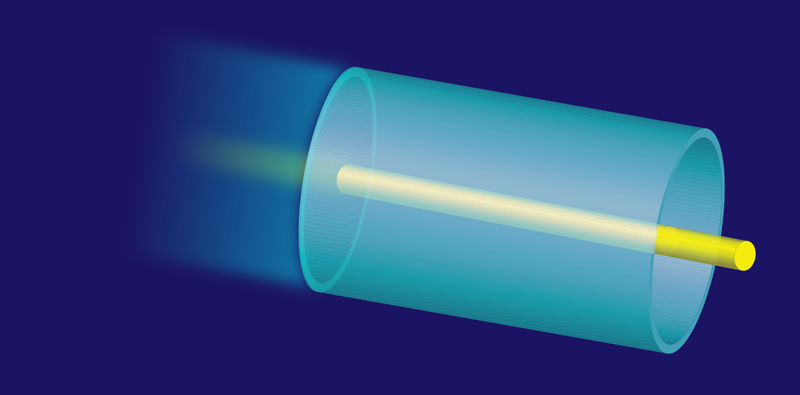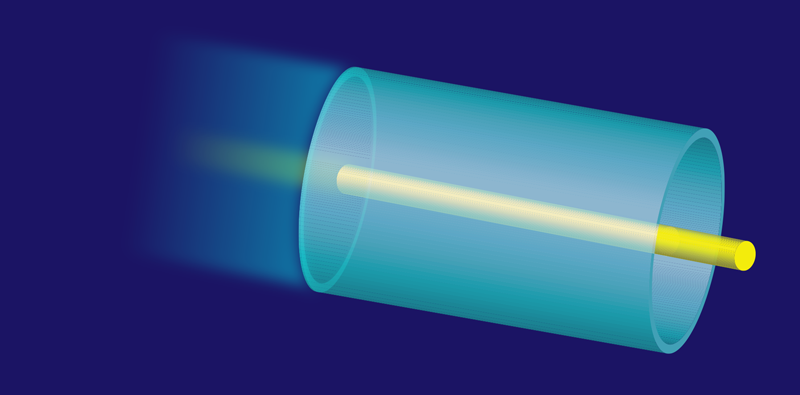Sculpting a Waveguide with Light
Accelerating charged particles using intense laser pulses instead of radio-frequency fields could dramatically reduce the sizes of high-energy particle accelerators. Unfortunately, the laser pulses can be hard to control, but a new waveguiding scheme could provide significant progress [1]. The idea builds on previous studies that used a laser pulse to create a plasma channel through the center of a tube of gas. The new technique uses a pair of pulses—one sculpting the “core” and one defining the “skin” of the waveguide—allowing more detailed control over the properties of the waveguide than was previously possible. This scheme could make laser-based accelerators more practical, efficient, and powerful.
In laser wakefield acceleration (LWFA), an intense laser pulse moves through a plasma, generating a region of positive charge that travels behind the pulse. Electrons attracted to these charges can be accelerated much more rapidly than in conventional particle accelerators—a few centimeters of LWFA can be equivalent to hundreds of meters of conventional acceleration. The accelerated electrons could be used to generate x-rays, potentially replacing x-ray sources like synchrotrons with far smaller systems. A cascade of many LWFA stages could also theoretically reach energies comparable to those of proposed facilities like the 30–50-km-long International Linear Collider.
However, researchers still need to improve the stability, energy, and quality of the electron beams produced by LWFA. They also need to boost the repetition rate: Previous experiments that achieved GeV-scale energies could only accelerate one electron bunch per second at best, far from the kilohertz or higher rates that would be required for a competitive LWFA-based x-ray source.
Howard Milchberg and his colleagues at the University of Maryland in College Park addressed these limitations by improving a key component of LWFA: the waveguide that keeps the driving laser pulse focused over a sufficiently long distance. Typically, this waveguide is prepared in a capillary tube filled with hydrogen gas, where a high-voltage discharge produces a plasma with lowest density along the tube axis and highest density some distance from the axis. This density profile confines the laser light in a narrow channel within the tube. One of these so-called capillary-discharge waveguides led to the current LWFA record electron energy of about 8 GeV. However, as the repetition rate is increased, it gets harder to remove the heat generated in the waveguide, and the walls of the capillary are gradually eroded by the hot plasma.
The Maryland team followed another approach called optical field ionization, in which the plasma channel is prepared by a laser pulse, rather than by an electric discharge. In this technique, the plasma is initially restricted to a narrow filament, but then it expands and leaves a less dense core surrounded by a denser outer surface, or “cladding.” In previous demonstrations, the waveguide was too leaky. “The key difficulty is to build a long waveguide with sufficient contrast between core and cladding,” says Milchberg.
Using optical technology that they recently developed, the team prepared a longer, more controllable, and less leaky waveguide. Their experiment uses two consecutive laser pulses that approximate Bessel beams, which are waveforms that don’t spread out as they propagate. The first pulse creates the core of the waveguide. The second pulse—a type of Bessel beam whose intensity is concentrated in a ring around the beam axis—creates the cladding. With this independent preparation of core and cladding, the team could form a waveguide with finely tunable parameters, such as the diameter and the density contrast between core and cladding.
To test the waveguide, the team injected a moderate-intensity laser pulse following the two waveguide-creating pulses and showed that the injected pulse could be guided for up to 30 cm. This length is similar to that of the longest capillary waveguides previously used for LWFA, but the new waveguide is 25 times smaller in cross-section and could be made smaller still, which allows for higher laser intensities. The researchers estimate that, using current laser technology, waveguides as long as several meters could be used to drive electrons up to 20 GeV.
“Flexibility is the key asset of this scheme,” says laser physicist Anthony Gonsalves of Lawrence Berkeley National Laboratory (LBNL) in California. One could tailor the waveguide parameters to be optimal for different applications, and the approach is inherently suitable for high repetition rates, he says. In 2019, Gonsalves and his collaborators achieved the 8 GeV LFWA record at LBNL with a 1 Hz repetition rate, but their future, upgraded system should reach 1 kHz. “This [optical ionization] approach might well turn out to be the method of choice,” says Gonsalves.
This research is published in Physical Review Letters.
–Matteo Rini
Matteo Rini is the Editor of Physics Magazine.
References
- B. Miao et al., “Optical guiding in meter-scale plasma waveguides,” Phys. Rev. Lett. 125, 074801 (2020).





